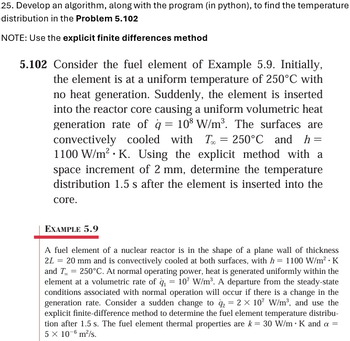
Elements Of Electromagnetics
7th Edition
ISBN: 9780190698614
Author: Sadiku, Matthew N. O.
Publisher: Oxford University Press
expand_more
expand_more
format_list_bulleted
Question
thumb_up100%

Transcribed Image Text:25. Develop an algorithm, along with the program (in python), to find the temperature
distribution in the Problem 5.102
NOTE: Use the explicit finite differences method
5.102 Consider the fuel element of Example 5.9. Initially,
the element is at a uniform temperature of 250°C with
no heat generation. Suddenly, the element is inserted
into the reactor core causing a uniform volumetric heat
generation rate of q = 108 W/m³. The surfaces are
convectively cooled with T = 250°C and_h=
1100 W/m² K. Using the explicit method with a
space increment of 2 mm, determine the temperature
distribution 1.5 s after the element is inserted into the
core.
EXAMPLE 5.9
A fuel element of a nuclear reactor is in the shape of a plane wall of thickness
2L = 20 mm and is convectively cooled at both surfaces, with h = 1100 W/m². K
and T=250°C. At normal operating power, heat is generated uniformly within the
element at a volumetric rate of q₁ = 107 W/m³. A departure from the steady-state
conditions associated with normal operation will occur if there is a change in the
generation rate. Consider a sudden change to %2 = 2 × 107 W/m³, and use the
explicit finite-difference method to determine the fuel element temperature distribu-
tion after 1.5 s. The fuel element thermal properties are k=30 W/m • K and a =
5 × 10-6 m²/s.
.
Expert Solution
This question has been solved!
Explore an expertly crafted, step-by-step solution for a thorough understanding of key concepts.
Step by stepSolved in 1 steps with 2 images

Knowledge Booster
Similar questions
- PARTS A and B ( Label Them ) SOLVE CAREFULLY!! Please Write Clearly and Box the final Answer for both Question : Chilled pharmaceutical is transported through a steel pipe ( k= 15.0 W/m.k) with an inner diameter of 36 mm and a wall thickness of 2 mm. The liquid and ambient air are at temperatures of 5 C and 25 C, while the inner and outer convection coefficients are 500 W/m2.K and 10 W/m2.K respectively. If a 10 mm thick layer of calcium silicate ( k= 0.05 W/m.K) is applied to the tube, answer the following questions: Part A : What is the heat gain per 1m of the tube? Part B : What is the outside temperature of the calcium silicate?arrow_forward### Given the resolution of the problem 5.102 below, develop a python program that shows the found temperature distribution PROBLEM 5.102 KNOWN: Fuel element of Example 5.8 is initially at a uniform temperature of 250°C with no internal generation; suddenly a uniform generation, q = 10³ W/m³, occurs when the element is inserted into the core while the surfaces experience convection (To,h). FIND: Temperature distribution 1.5s after element is inserted into the core. SCHEMATIC: PROBLEM 5.102 (Cont.) To be well within the stability limit, select At = 0.3s, which corresponds to Fo aAt 5x10 m²/sx0.3s 4x² t=pAt=0.3p(s). =0.375 (0.002m)² Fuel element- x=5x10 m²/s k-30W/m-K Coolant Too-250°C h-1100 W/m²-K رجا T(x,0)=250°C 9-10°W/m³ at +>0 Coolant Too,h L-10mm k+ax=2mm ASSUMPTIONS: (1) One-dimensional transient conduction, (2) Constant properties, (3) q=0, initially; at t> 0, q is uniform. ANALYSIS: As suggested, the explicit method with a space increment of 2mm will be used. Using the nodal…arrow_forwardConsider the square channel shown in the sketch operating under steady state condition. The inner surface of the channel is at a uniform temperature of 600 K and the outer surface is at a uniform temperature of 300 K. From a symmetrical elemental of the channel, a two-dimensional grid has been constructed as in the right figure below. The points are spaced by equal distance. Tout = 300 K k = 1 W/m-K T = 600 K (a) The heat transfer from inside to outside is only by conduction across the channel wall. Beginning with properly defined control volumes, derive the finite difference equations for locations 123. You can also use (n, m) to represent row and column. For example, location Dis (3, 3), location is (3,1), and location 3 is (3,5). (hint: I have already put a control volume around this locations with dashed boarder.) (b) Please use excel to construct the tables of temperatures and finite difference. Solve for the temperatures of each locations. Print out the tables in the spread…arrow_forward
arrow_back_ios
arrow_forward_ios
Recommended textbooks for you
 Elements Of ElectromagneticsMechanical EngineeringISBN:9780190698614Author:Sadiku, Matthew N. O.Publisher:Oxford University Press
Elements Of ElectromagneticsMechanical EngineeringISBN:9780190698614Author:Sadiku, Matthew N. O.Publisher:Oxford University Press Mechanics of Materials (10th Edition)Mechanical EngineeringISBN:9780134319650Author:Russell C. HibbelerPublisher:PEARSON
Mechanics of Materials (10th Edition)Mechanical EngineeringISBN:9780134319650Author:Russell C. HibbelerPublisher:PEARSON Thermodynamics: An Engineering ApproachMechanical EngineeringISBN:9781259822674Author:Yunus A. Cengel Dr., Michael A. BolesPublisher:McGraw-Hill Education
Thermodynamics: An Engineering ApproachMechanical EngineeringISBN:9781259822674Author:Yunus A. Cengel Dr., Michael A. BolesPublisher:McGraw-Hill Education Control Systems EngineeringMechanical EngineeringISBN:9781118170519Author:Norman S. NisePublisher:WILEY
Control Systems EngineeringMechanical EngineeringISBN:9781118170519Author:Norman S. NisePublisher:WILEY Mechanics of Materials (MindTap Course List)Mechanical EngineeringISBN:9781337093347Author:Barry J. Goodno, James M. GerePublisher:Cengage Learning
Mechanics of Materials (MindTap Course List)Mechanical EngineeringISBN:9781337093347Author:Barry J. Goodno, James M. GerePublisher:Cengage Learning Engineering Mechanics: StaticsMechanical EngineeringISBN:9781118807330Author:James L. Meriam, L. G. Kraige, J. N. BoltonPublisher:WILEY
Engineering Mechanics: StaticsMechanical EngineeringISBN:9781118807330Author:James L. Meriam, L. G. Kraige, J. N. BoltonPublisher:WILEY

Elements Of Electromagnetics
Mechanical Engineering
ISBN:9780190698614
Author:Sadiku, Matthew N. O.
Publisher:Oxford University Press

Mechanics of Materials (10th Edition)
Mechanical Engineering
ISBN:9780134319650
Author:Russell C. Hibbeler
Publisher:PEARSON

Thermodynamics: An Engineering Approach
Mechanical Engineering
ISBN:9781259822674
Author:Yunus A. Cengel Dr., Michael A. Boles
Publisher:McGraw-Hill Education

Control Systems Engineering
Mechanical Engineering
ISBN:9781118170519
Author:Norman S. Nise
Publisher:WILEY

Mechanics of Materials (MindTap Course List)
Mechanical Engineering
ISBN:9781337093347
Author:Barry J. Goodno, James M. Gere
Publisher:Cengage Learning

Engineering Mechanics: Statics
Mechanical Engineering
ISBN:9781118807330
Author:James L. Meriam, L. G. Kraige, J. N. Bolton
Publisher:WILEY